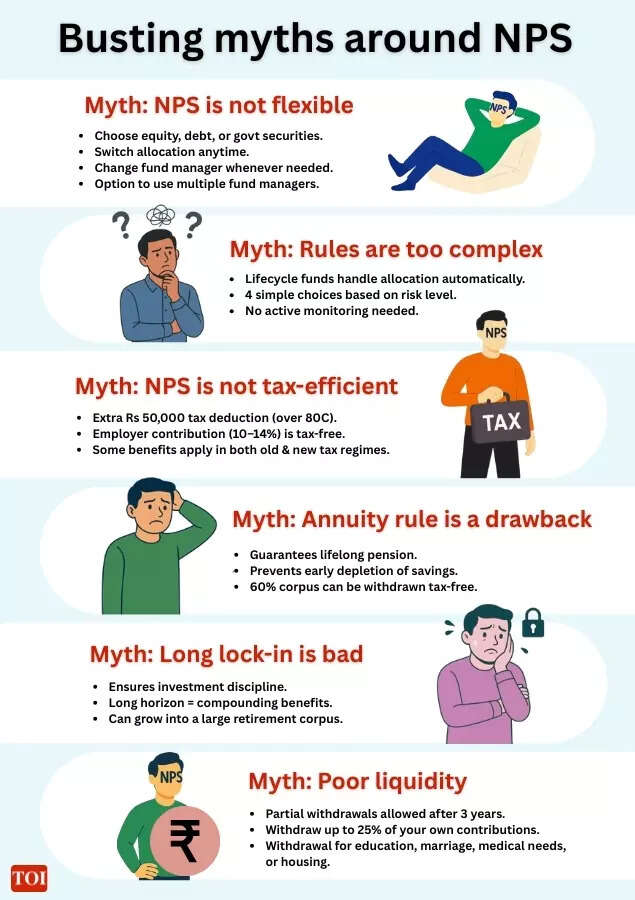NPS myths busted! Why National Pension System is one of the smartest retirement plans – explained

NPS myths busted! When it comes to building a retirement corpus, few instruments are as efficient, disciplined and tax-friendly as the National Pension System (NPS). Yet, despite being a thoughtfully designed long-term savings product, it has failed to gain mass popularity among investors. Many working professionals, even those who plan meticulously for their financial goals, give NPS a miss. The reasons are a clutch of misconceptions that refuse to go away.It’s time to take a closer look at these myths and explain why NPS deserves a place in every long-term investor’s portfolio:
Myth 1: NPS is inflexible
One of the biggest myths about NPS is that it ties your hands once you start investing. On the contrary, the NPS offers a level of flexibility that even mutual funds don’t. Investors can choose their own mix of equity, corporate debt, and government securities—called asset classes—and switch between them as their risk appetite changes. More importantly, NPS investors can also change their pension fund manager (PFM) if they are dissatisfied with performance.And there’s more. In 2022, the Pension Fund Regulatory and Development Authority (PFRDA) introduced a provision allowing investors to choose multiple fund managers—one each for different asset classes. That means you could have one manager for equities, another for debt, and a third for government securities, giving you the benefit of professional diversification within your retirement portfolio. All this can be done with a few clicks of the mouse and without any tax implication. This level of flexibility and control is unmatched in any other long-term investment product.
Myth 2: NPS is not tax-efficient
This is also incorrect. In reality, NPS is one of the most tax-efficient investment options available to Indians. Under Section 80CCD(1B) of the Income Tax Act, you can claim an additional deduction of ₹50,000 for NPS investments over and above the ₹1.5 lakh limit under Section 80C. That makes it a total tax-saving potential of ₹2 lakh under the old regime.But the bigger, often overlooked benefit comes when your employer contributes to your NPS account. Under Section 80CCD(2), an employer’s contribution of up to 10% of basic salary plus dearness allowance is exempt from tax. This benefit applies under both the old and the new tax regimes, where the deduction is even higher at 14% of the basic. This makes NPS one of the rare tax-saving avenues available even to those who have opted for the new system.In short, NPS gives you tax breaks when you invest, and even when your company invests on your behalf. Few products can match that.
Myth 3: The investment rules are too complex
Even if you don’t understand financial jargon or market dynamics, NPS ensures your money is invested wisely and in tune with your age and goals.For investors who aren’t comfortable making allocation decisions between equity and debt, NPS has a simple and elegant solution—lifecycle funds. These are pre-designed portfolios that automatically adjust the mix of equity and debt as you age. Younger investors start with a higher equity exposure, which gradually tapers off in favour of safer assets like government bonds as they near retirement.There are four such lifecycle funds—Conservative, Moderate, Balanced, and Aggressive—to match different risk appetites. Once you choose one, the system does the rest, adjusting your portfolio each year without any effort from your side.

NPS myths busted
Myth 4: The long lock-in period is a drawback
Yes, NPS is designed as a retirement product, and your funds are locked in until you reach 60. But that should not be seen as a flaw but a useful feature. The single biggest challenge for most savers is sticking to their investment plan. Market volatility, changing life goals, or short-term temptations often derail even the best-laid financial plans. NPS removes that behavioural risk by enforcing discipline.Moreover, the long investment horizon allows your money to compound—the most powerful force in wealth creation. The combination of regular contributions, market-linked growth, and tax advantages can result in a surprisingly large corpus by the time you retire.For example, an investor contributing ₹5,000 a month from age 30 could build a retirement pot of over ₹1.7 crore by 60, assuming a modest 9% annual return. That’s the magic of staying invested for the long term.
Myth 5: NPS has poor liquidity
It’s true that NPS is meant for long-term savings, but it’s not as rigid as many believe. Partial withdrawals are permitted for specific purposes—like a child’s education or marriage, medical emergencies, or buying or constructing a house.You can withdraw up to 25% of your contributions, subject to certain conditions, after three years of investment. So while the scheme promotes discipline, it also recognises that life can be unpredictable and offers room for genuine contingencies.
Myth 6: The annuity rule is a problem
Upon retirement, at least 40% of your NPS corpus must be used to buy an annuity, which provides a lifelong pension. Some investors see this as restrictive, since annuity rates in India are not very high.However, this rule also ensures that retirees don’t exhaust their savings too quickly. The monthly pension acts as a steady income stream, which is crucial for maintaining financial independence in old age. Moreover, the remaining 60% of the corpus can be withdrawn tax-free, giving retirees a significant lump sum to meet immediate post-retirement expenses or to reinvest elsewhere.In an era when private-sector employees have no guaranteed pension and traditional instruments like the EPF are struggling to beat inflation, NPS fills a critical gap. It’s a low-cost, market-linked, tax-efficient, and well-regulated system designed to help Indians retire with dignity.The NPS is a flexible product that rewards discipline and long-term thinking. Investors who look past the myths and understand its true benefits will find that it’s not just a good product but one of the smartest retirement investments available today.






